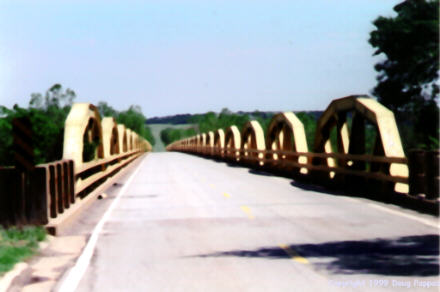Yep, I survived the Oklahoma tornadoes. About 40 others in metropolitan Oklahoma City didn't. 500 more were injured and thousands were left homeless in what was described as the largest wave of tornadoes in Oklahoma history. But where I was, on the northeast side of town, it rained harder this morning than at any time during the tornadoes.
In fact, I was struck by how little damage the rest of the metropolitan area sustained. Unlike hurricanes and similar storms, where the worst devastation is usually surrounded by areas hit almost as bad, tornadoes can destroy everything on one block while leaving the next block totally untouched. Even when I drove west through Yukon and El Reno, on a road across which at least one tornado had passed the night before, there was no visible damage anywhere. Not even a pile of downed branches.
After delaying my departure to let a wave of heavy thunderstorms pass, I began my day at the National Cowboy Hall of Fame. Most of the museum is actually devoted to Western art, with rodeo performers and Western-movie actors also getting their due. Route 66 then runs past the Oklahoma capital building (the only one in the nation with an oil well on the grounds) before turning west to parallel I-40.
66 across western Oklahoma is as good as road tripping gets, alternating miles of open road with cruises down small-town Main Streets and never requiring me to drive on the Interstate. I could've shot four rolls of film today, but settled for only a roll and a half. By the time I reached Yukon, 20 miles west of Oklahoma City, the sun was shining brightly, and it remained sunny all the way to New Mexico.

In the past five years, two western Oklahoma towns have built their own Route 66 museums. Clinton's Route 66 Museum gets the nod over Elk City's National Route 66 Museum, displaying everything from pre-66 maps to road construction equipment to a reconstructed local diner, all heavily illustrated with postcard images and accompanied by taped narration from Michael Wallis, author of Route 66: The Mother Road. Great gift shop, too.
I had moved into the Land of the Tacky Roadside Gift Shop, from the Cherokee Trading Post east of Clinton to Amarillo's Big Texan Steak Ranch, which challenges diners: eat a 72-ounce steak, plus side dishes, in an hour and it's free. About a quarter of those who attempt to down 4-1/2 pounds of beef in 60 minutes succeed. I didn't try. Even spotted the trip's first Stuckey's, fifteen miles east of the New Mexico border -- I'll see a lot more of those tomorrow.
Route 66 across northern Texas is nowhere near as scenic as its Oklahoma counterpart. Whereas Oklahoma left Route 66 alone while building the nearby Interstates, Texas often built the Interstate directly atop 66, or just a few feet away. But Texas's Route 66 is much easier to navigate: stay on the Interstate, except to follow the "historic route 66" loops through every town of consequence.
In one of those towns, McLean, the Texas Route 66 museum and Hall of Fame shares space with the Devil's Rope Museum, which shows and tells more than any sane person would ever want to know about barbed wire. Did you know that there's a thriving community of people who collect different types of barbed wire? Sounds like a potentially painful hobby -- and I doubt that the collectors would want to be known as "Barbies." McLean also boasts a 1929 Phillips 66 station restored to its original appearance.
Neighboring Alanreed countered by restoring a more elaborate 1930 station, but inadequate maintenance has left the Alanreed station overrun by weeds.
A traveler on the Interstate encounters bizarre sights at both ends of Groom, Texas. On the east side of town, a water tower was constructed with one leg shorter than the other to make it appear to be falling down, while on the west side a religious group erected what it claims to be the largest cross in the Western Hemisphere, 190' tall, surrounded by Stations of the Cross depicting Christ's last hours.
66 passes through Amarillo on a 20-mile loop. Just west of town, the eccentric "Cadillac Ranch" sculpture -- nine vintage Cadillacs buried in the ground -- was recently relocated a mile or two further west, in a field which remains active cattle grazing land. No signs or markers point the traveler's way. Finally, just before the New Mexico line in the virtual ghost town of Glenrio, a cracked motel sign proclaims "Last Motel in Texas" to westbound travelers, "First Motel in Texas" to the eastbound.
I stopped for the night in Tucumcari, New Mexico, the biggest Town of Motels this side of Breezewood, Pennsylvania. As the only town of any size between Amarillo and Albuquerque, a distance of about 260 miles, Tucumcari has more than one motel room for each of its 2,000 residents, stretched out along a five-mile strip of old 66. Midway down this strip lies the Blue Swallow Motel, 50-year-old home to the best neon sign anywhere along 66. Rates at the Blue Swallow, and many other mom 'n' pop motels in town, start at $19.95/night. I paid more for a modern chain motel, figuring I'd be able to send and receive E-mail, but the local phone system is so antiquated that I can't get a connection.
I'm hoping to reach Flagstaff tomorrow night, from which E-mail access should be easy. If I fall short and end up in Winslow or Holbrook instead, you may receive three days of updates at once instead of just two...
Go to the next day
Back to NEWS FROM THE ROAD menu
Back to ROADSIDEPHOTOS.COM home page